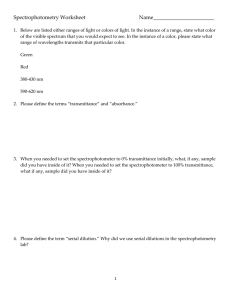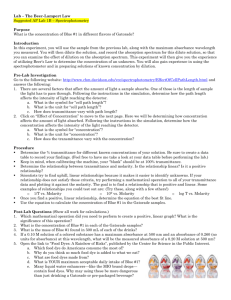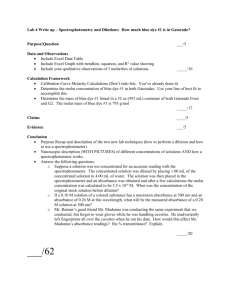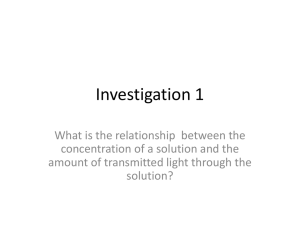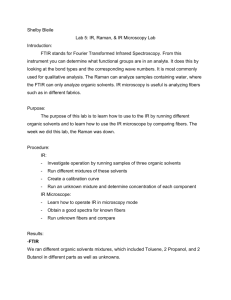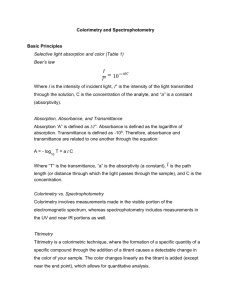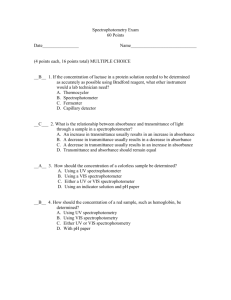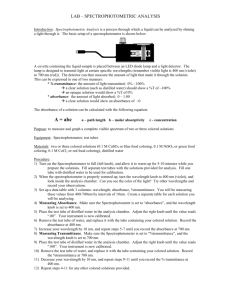Solutions Lab Report - Neville High School
advertisement
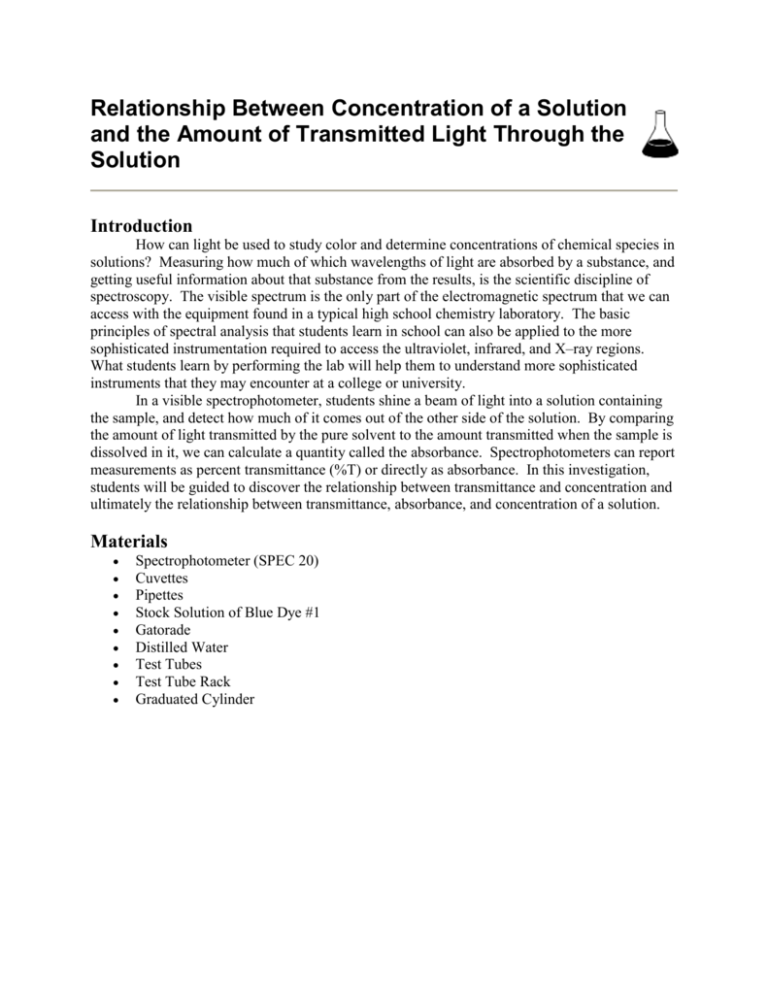
Relationship Between Concentration of a Solution and the Amount of Transmitted Light Through the Solution Introduction How can light be used to study color and determine concentrations of chemical species in solutions? Measuring how much of which wavelengths of light are absorbed by a substance, and getting useful information about that substance from the results, is the scientific discipline of spectroscopy. The visible spectrum is the only part of the electromagnetic spectrum that we can access with the equipment found in a typical high school chemistry laboratory. The basic principles of spectral analysis that students learn in school can also be applied to the more sophisticated instrumentation required to access the ultraviolet, infrared, and X–ray regions. What students learn by performing the lab will help them to understand more sophisticated instruments that they may encounter at a college or university. In a visible spectrophotometer, students shine a beam of light into a solution containing the sample, and detect how much of it comes out of the other side of the solution. By comparing the amount of light transmitted by the pure solvent to the amount transmitted when the sample is dissolved in it, we can calculate a quantity called the absorbance. Spectrophotometers can report measurements as percent transmittance (%T) or directly as absorbance. In this investigation, students will be guided to discover the relationship between transmittance and concentration and ultimately the relationship between transmittance, absorbance, and concentration of a solution. Materials Spectrophotometer (SPEC 20) Cuvettes Pipettes Stock Solution of Blue Dye #1 Gatorade Distilled Water Test Tubes Test Tube Rack Graduated Cylinder Procedure Part 1 – Determining a Calibration Graph 1. Review how to use the SPEC 20. 2. Determine the percent transmittance (at 630 nm) and absorbance of various dilutions of the stock Blue #1 solution (Stock Solution concentration = 7.8 µM). Record your results in the data table. 10 mL stock / 0 mL water 8 mL stock / 2 mL water 6 mL stock / 4 mL water 4 mL stock / 6 mL water 3 mL stock / 7 mL water 2 mL stock / 8 mL water 1 mL stock / 9 mL water 0 mL stock / 10 mL water 3. Use the Beer’s Law to calculate the concentration for each dilution ( A = e ´ b ´ c ). A = Absorbance (no units), e = Molar Absorptivity (cm–1 M–1), b = path length (cm), c = Concentration (mol/L) Molar Absorptivity for Blue #1 = 130,000 cm–1 M–1. b = 1 cm 4. Determine the relationship between transmittance and molarity of the solution (graph the data – plot the concentration (µM) on the x–axis versus transmittance (T) on the y–axis). 5. To get a better understanding of the relationship between concentration and transmittance, try to find a way to get a graph that is a straight line that goes through zero. Get with other groups and try to come up with a graph that produces a straight line that goes through the origin (hint: try manipulating the transmittance values mathematically). 6. Once you have a straight line, you have found the calibration line – this can be used to find the concentration of an unknown solution. Part 2 – Determining the Concentration of an Unknown Solution 1. Using the information gained from Part 1 of the Lab, design a data–collection and data analysis procedure to determine the molarity or concentration of Blue #1 dye in the Gatorade. 2. Determine the molar concentration of Blue #1 in the Gatorade (show all work). 3. Determine the mass of the Blue #1 dye found in 500 mL of the drink (show all work) (Molar Mass of Blue #1 = 793 grams per mole). Data Table (Part 1) Solution Dilution Ratio (mL stock / mL water) 1. (stock solution) 10 mL / 0 mL 2. 8 mL / 2 mL 3. 6 mL / 4 mL 4. 4 mL / 6 mL 5. 3 mL / 7 mL 6. 2 mL / 8 mL 7. 1 mL / 9 mL 8. 0 mL / 10 mL Absorbance Measured Molar Measure % Transmittance Concentration Transmittance as a Decimal (µM) Post Lab Questions 1. Suppose a solution was too concentrated for an accurate reading with the spectrophotometer. The concentrated solution was diluted by placing 1.00 mL of the concentrated solution in 4.00 mL of water. The solution was then placed in the spectrophotometer and an absorbance was obtained and after a few calculations the molar concentration was calculated to be 3.5x10–6 M. What was the concentration of the original stock solution before dilution? 2. If a 0.10 M solution of a colored substance has a maximum absorbance at 500 nm and an absorbance of 0.26 at this wavelength, what will be the measured absorbance of a 0.20 M solution at 500 nm? 3. The spectrophotometer really measures the percent of light that is transmitted through the solution. The instrument then converts the %T (transmittance) into absorbance by using the equation you determined in the prelab section. If the absorbance of a sample is 0.85, what is the percent of light transmitted through the colored sample at this collected wavelength?
